► Porsche racing cars driven at Estoril
► Behind the wheel of the 911 GT3 Cup and 911 GT3 R
► What makes a great racing car?
Driving the spectacularly good Porsche 911 GT3 RS, it’s hard to imagine how any 911 could ever deliver anything beyond its astounding levels of pace, telepathic feel and laugh-out-loud fun. Pound-for-pound (assuming you can get one for list price, that is), it’s one of the most astonishing cars on sale today and sits atop of perhaps the greatest model line in the history of sports cars. In short, it’s the real deal.
And yet, believe it or not, Porsche reckons there’s not one, but two 911 models that go beyond its most outrageous road car. Intrigued, we made the trip to the famous Estoril circuit in southern Portugal for a chance to drive two 911s that you’re unlikely to ever see on the public highway – namely the Porsche 911 GT3 Cup and GT3 R.
The motorsport equivalents of Stuttgart’s iconic road car, this is what happens when engineers don’t have to worry about things like comfort, refinement or even where your mobile phone will sit in the cabin. Even by the standard of the GT3 RS, these are 911s designed to go fast and nothing else.
Porsche 911 GT3 Cup
First up, the 911 GT3 Cup. Seen as the feeder car for Porsche’s elite crop of factory drivers and a popular racing car in its own right, the 911 GT3 Cup is now in its sixth generation with over 5,000 cars produced. The first was presented in 1990 and based on the 964, with the latter now using the 992 as a platform and priced from £193k (plus VAT).
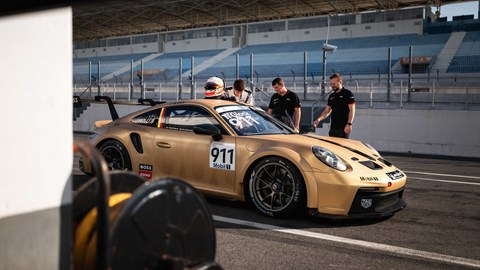
Porsche claim that the development goals for the 992 Cup cars were focused on greater performance (naturally), but also a more striking design and, perhaps most importantly, making it easier to drive. That’s because the 991.2 Cup car had a reputation for being one of the trickiest racing cars to master and while that’s fine for the supremely talented young guns looking to make a name for themselves, it’s less ideal for gentleman drivers after a reliable, competitive racing car.
It also might be unusual to hear that improving the car’s looks was set as a key target, yet with so many eyeballs watching coverage of 911 Cup racing cars, looking their best is a worthy consideration. As such, the 992 generation car is – to these eyes – significantly easier on the eye than what came immediately before it.
This is largely because it’s the first time the wider, Turbo-spec body shell has been used, meaning a far broader front and rear end and 12- and 13-inch wide rims respectively. What’s more, one of the most striking features from the road car, the swan-neck rear spoiler, also makes its way onto the Cup car and offers eleven stages of adjustability.
Meanwhile, whereas the 991.2 Cup car consisted of 70% steel and 30% aluminium, that ratio has been reversed for the 992. Despite this, the dry weight still comes in 35kg more than before at 1,260kg, with this largely due to additional safety equipment such as the extra struts on the steel safety cell.
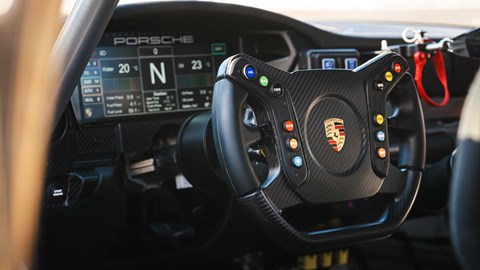
All good stuff, but the intention to develop the car outside of simply making it faster is one of the first things that you appreciate before driving the car. For example, the seat has two height adjustment settings, while the steering wheel buttons have been rearranged following driver feedback. Also, the engine cover can be hung from a hook on the spoiler while removed for servicing and the brake callipers have been switched to enable faster brake pad changes.
These are just small examples of how Porsche has taken on feedback and tried to make 911 Cup car easier to race. Even the service intervals, 100 hours of track time between maintenance checks for the engine and 120 hours between major overhauls for the gearbox, stand out.
Porsche 911 GT3 R
It seems odd to be discussing anything outside of raw speed when it comes to racing cars, yet it’s an approach that’s not only confined to the GT3 Cup cars. Even the latest GT3 R – Porsche’s Ferrari/Audi/Mercedes-AMG battling GT3 entry – has a range of priorities. Costing from £439k (plus VAT), Porsche’s priority was to improve driveability for professionals and gentleman drivers, while also enabling the car to deal with various BoP classifications more effectively.
BoP, or Balance of Performance to give it it’s full title, is designed to keep sportscar racing as close as possible to ensure the greatest spectacle with the most competitive racing. As such, the governing body of the series will attempt to bring each car’s performance onto a level playing field by means such as limiting the engine (through a restrictor or boost reduction) or adding ballast. Therefore, it’s essential that the cars are able to manage their BoP effectively.
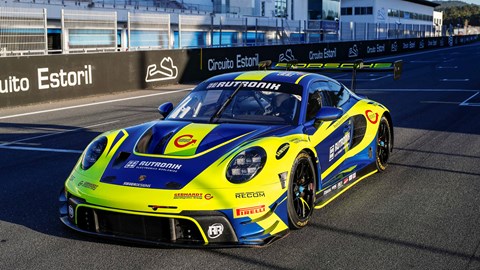
Of course, speed is always critical in racing, but in this case making the car easier to drive faster for longer is almost as important. To do this, Porsche focused on delivering an engine that has a broader usable power band as well as more stable and consistent that creates a lower load on the rear tyres.
The engine itself isn’t far from standard, yet key changes include increasing displacement from 4.0-litres to 4.2, yielding a power increase up to 557bhp. Power and torque curves have also been optimised across the entire rev range to allow less experienced drivers to extract the most from the powertrain.
Also, the engine has been tilted forward by 5.5 degrees thus creating more space for an underbody diffuser, while auxiliary units such as the alternator and air-con compressor were moved forward by more than a metre to improve weight balance. Furthermore, the suspension setup drew inspiration from the 911 RSR racing car, with a double wishbone setup at the front and a multi-link arrangement at the back. KW shock absorbers offer five different settings through the use of shims – essentially small plates that allow adjustment without the need realign the suspension afterwards.

Take a step back from the GT3 R, and it’s also obvious that the wheelbase has been extended by around 5 cm by moving the rear wheels further back than the road 911 GT3. This reduces the load on the rear tyres and improves the consistency of their performance over longer stints, while also making the car noticeably different in appearance to the 911 Cup car.
Upgraded brakes (with an improved fifth-gen racing ABS system that reduces wear on brakes and tyres) and an aluminium-steel composite chassis (with carbon panels) are also present, as is a six-speed sequential constant-mesh gearbox.
What are they like to drive?
After a few nausea-inducing sighting laps with 2023 Porsche Supercup champion Bastian Buus (remember the name), I got behind the wheel of the Cup car first. Somehow, it seemed easier, more forgiving. How much different could it be to a 911 GT3 RS, or even a regular GT3 road car for that matter?
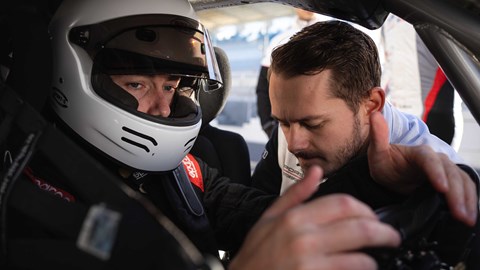
I got my answer as soon as I deactivated the pit limiter. Bang. With 503bhp at 8,400rpm, it’s not any more powerful than a 911 GT3, yet the immediacy of acceleration is almost violent. The noise, too, is incredible. At low speeds, the whine of the gearbox dominates, but the familiar mechanical rasp of the 4.0-litre flat-six is ever present as I tear through 1st, 2nd and 3rd gear. It’s a great seating position, similar to the road car but you’re held in far more tightly.
As such, you feel every last movement, bump and shot of energy that moves through the car. Unlike the road version, everything is solid, designed to transmit as much detail as possible to the driver’s hands and body to get the most out of the car underneath them. Even just running the tyres in on the out lap, it feels like a properly physical experience even if the steering is lighter than you might expect.
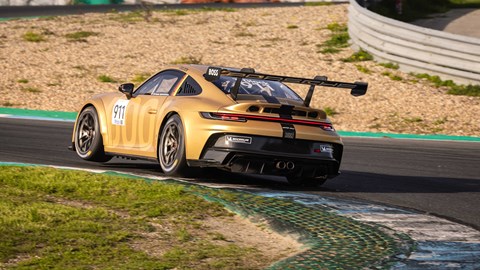
For this demonstration run, we’re using traction control and ABS – something that Porsche Supercup drivers (you might recognise it as a Formula 1 support series) don’t have. Indeed, after driving the car with ABS switched on, Buus notes that much of the challenge is taken away as so much of the skill is in nailing the braking. Not just in how late you stand on the anchors, but also in how you then meter the pedal out as you approach the apex. With little weight over the nose, the key is to get the car slowed and rotated quickly, to then jump on the power as early as possible and lean on the monstrous rear-end traction. It’s a driving style that differs to other racing cars and relies heavily on deft trail braking and timing.
Regardless of the ABS, however, the braking is stand-out. It’s incredible how aggressive you can be on the pedal before any kind of lockup occurs (lights on the dashboard show when this happens) and the stopping power wipes off speed ferociously. The whole experience is a violent whirlwind of grip, power and feel yet it’s addictively brilliant fun. Truly and utterly. It encourages you to drive it like you’ve stolen it more than any other racing car this writer has driven and feels totally on your side, egging you on to go quicker and quicker. A quick look at the results sheets from last year’s Supercup proves how close it is, with each car separated by mere hundredths of a second, the entries identical bar set-up and driver.
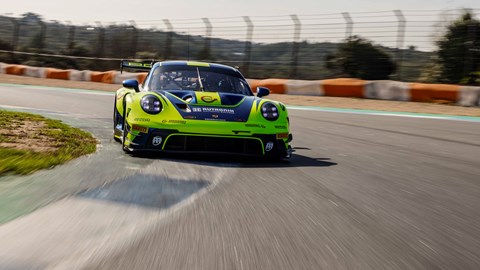
It’s a notably different experience to the GT3 R, where less aggression and more finesse seems to be the best way to get the most out of it. Much of this is likely down to the additional aero, but also the longer wheelbase makes the car feel more stable allowing you to take greater speed through corners. Indeed, even though it didn’t always feel as quick, telemetry showed I was carrying more speed in the faster and slower corners than the GT3 Cup.
The seating position was also more laid back and single-seater esque, with the 911 cockpit design feeling less prominent than it did in the Cup car. Essentially, the GT3 R felt like a racing car that happened to look like a 911, whereas the Cup gave the impression of a 911 that had been converted into a racing car.
Through the high-speed corners, especially the final turn of Estoril where Villeneuve passed Schumacher around the outside in 1996, the GT3 R was being sucked into the ground with the force increasing as the speedometer rose. It’s nowhere near the most downforce-intensive of modern racing cars, yet the feeling was still palpable.
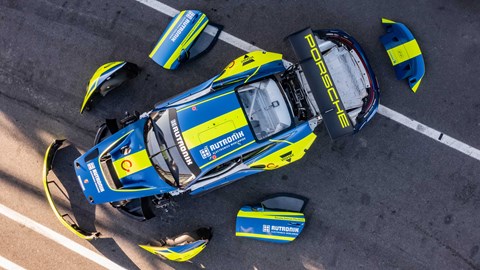
What’s more, that extra chunk of power of the GT3 Cup was noticeable. Whereas the latter felt like it was running out of puff above 130mph, the R had that little more in the tank – pulling hard down the long main straight and then feeling strikingly settled as we hit the brakes for the tight turn 1 – ears bursting from the 4.2-litre onslaught of the last few seconds.
Verdict
The 911 GT3 Cup and GT3 R move the game on from even the mightiest 911 road cars. When it comes to outright performance, a GT3 RS may be close to the former, yet the raw and visceral experience – plus the skill required to gain the performance out of them – is on another level. And while it’s perhaps not hard to imagine the joy of driving two examples of Porsche’s enviable stable of racing cars, what also stands out is what makes them so commercially successful.
It’s not something we usually think of when it comes to motorsport, but – like with its road cars – Porsche has gone to considerable lengths to make its racing cars as appealing as possible not just to the drivers, but also those that pay for and run the cars.
Speaking to members of the racing team (not owned by Porsche) who were running the GT3 R on the day, they confirmed that 911s are often quicker to fix and easier to work on than rival cars – something that counts for a huge amount in endurance racing. So next time you’re wondering why Porsche’s customer motorsport presence is still so vast, then it’s worth remembering that there’s more to an ideal racing car than just raw speed.

Pictures by Jürgen Tap and Rossen Gargolov